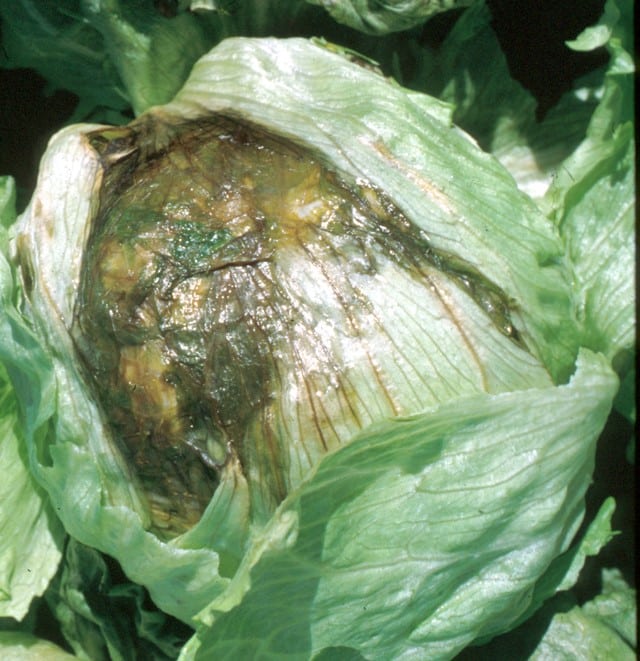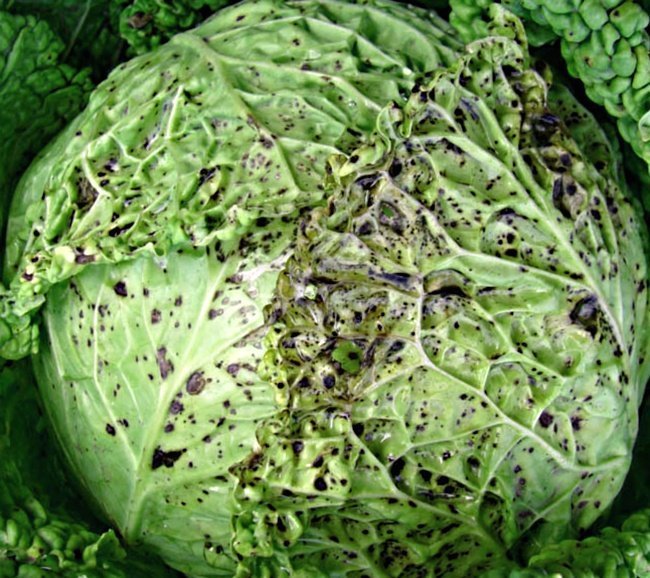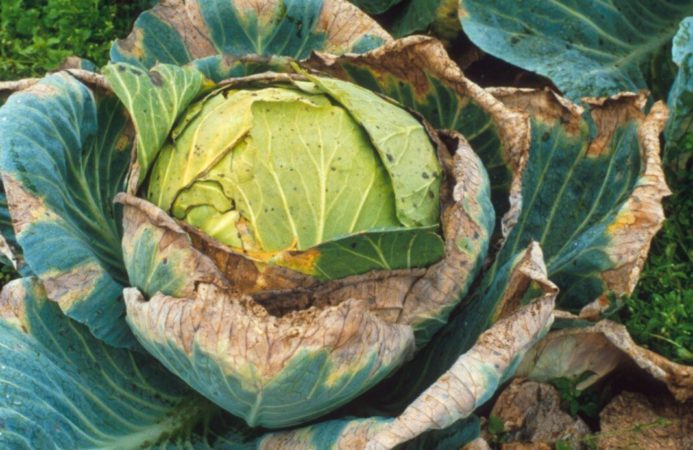Cabbage diseases: description with photographs, methods of treatment and prevention
Infection of cabbage with dangerous diseases is determined by external signs. Therefore, gardeners carefully monitor the condition of the leaves. Cabbage suffers from many diseases, including fungal, viral and bacterial infections. It is important to know how to identify and treat them. Read the article about diseases of white cabbage and the fight against them.
Description of cabbage diseases and methods of treating them
The main reason for cabbage infection by fungi and bacteria is non-compliance with agrotechnical recommendations.
The main factors contributing to the occurrence of diseases:
- non-compliance with crop rotation;
- neglect to disinfect the beds and seeds before planting;
- excessive soil moisture;
- uncollected plant residues;
- lack of fertilizing;
- invasion of pests that carry dangerous microorganisms;
- adding nitrogen at the end of plant development.
Also illnesses occur due to unfavorable weather conditions. Due to temperature changes, cabbage weakens and becomes susceptible to infections. It is important to recognize the signs of disease in time to save the harvest.
Important! When buying seedlings on the market, there is always a risk of purchasing infected plants.
We will provide a detailed description of the diseases with photographs and consider methods of treating them.
Mucous bacteriosis

Mucous bacteriosis is a disease that affects many vegetable crops. These include cabbage.The disease is most severe during storage or transportation at high temperatures.
If cabbage seedlings are affected by mucous bacteriosis, oily spots appear on the leaves and cotyledons. This gradually leads to underdevelopment of the plant, which often causes its death.
When tying a head of cabbage, the upper leaves turn brown. In wet weather, they become covered with mucus and begin to rot, which is why the disease is also called wet rot. In dry weather, damaged areas dry out, become translucent and thin.
Rotting of the inside of the vegetable and the formation of voids in the stalks are often noted. Such heads of cabbage smell bad. They usually fall off the stumps before they have time to ripen.
If the inside is not badly damaged, the cabbage has time to ripen. But after being sent for storage, it quickly rots. This leads to contamination of healthy vegetables.
To combat mucous bacteriosis, the biological preparation Fitosporin-M is most often used. He has already proven himself well. In addition to effective protection, this fungicide has a strong anti-stress effect and immunostimulating properties. This has a good effect on the crop under climatic and pesticide stress.
Read also:
How to get rid of caterpillars on dill: pest control methods
How to get rid of caterpillars on peppers
What to do if there are caterpillars in tomatoes - ways to combat the pest
Scab

Scab is a very dangerous infectious disease caused by pathogenic fungi and actinomycetes bacteria. It affects the surface of the leaves and significantly reduces the yield.
The main external signs of scab on cabbage:
- spots;
- peeling;
- cankers on leaves;
- warts;
- pustules.
To treat scab, fungicides with the third or fourth hazard class are used. Fitosporin, Zato, Skor or Bordeaux mixture are often used.
Vascular bacteriosis

This is a bacterial disease that affects the vascular system of cabbage. Main routes of infection:
- insufficiently rotted manure;
- undecomposed plant remains;
- infected seeds.
Improper watering regime and various insects contribute to the transfer of microorganisms. If bacteria enter a favorable environment, the disease progresses rapidly.
If the source of infection was seeds, the vessels of the root system will be the first to be affected. After some time, the disease will also spread to the cabbage leaves. The vascular bundles will gradually begin to turn black, and colorless areas will appear along the veins. After this, the leaves will turn yellow and dry out completely.
When infected, the leaves are the first to suffer due to mechanical damage. V-shaped spots appear on them. In any case, the disease will spread to the entire head of cabbage. To prevent cabbage from becoming infected with vascular bacteriosis, the following measures are taken:
- For sowing, only treated seeds from trusted companies are used.
- Pests and weeds are removed in a timely manner.
- Follow the rules of crop rotation. The bacterium can live in soil for 3 years.
Measures to combat vascular bacteriosis involve the use of biological or chemical drugs. The most commonly used are Fundazol, Planriz, and Fitolavin-300.
Fusarium wilt

Fusarium wilt is a disease of cabbage seedlings. Symptoms of infection are easy to notice: the leaves quickly turn yellow and lose their rigidity, and chlorosis appears between the veins of the lower leaves. As a result, the plant withers.
The leaf blade develops unevenly.Often the entire head of cabbage has a one-sided lesion. Due to the disease, the foliage falls off, and as the disease progresses, a small bare head of cabbage remains. A cross-section shows a brownish-brown ring of blood vessels.
Over time, Fusarium wilt moves up the plant. If the gardener does not take any measures, the cabbage dies prematurely.
Treatment methods for fusarium (its signs are clearly visible in the photo above):
- Sick plants are immediately dug up along with the rhizome and burned. If Fusarium infection occurs in a greenhouse, the soil must be completely replaced or disinfected.
- In autumn, when foci of disease appear, the soil is disinfected with a solution of copper sulfate. 5 g of product are diluted per 10 liters of water.
- To increase cabbage resistance to this disease, plants are sprayed with Immunocytophyte or Agat-25.
Gray rot

Gray rot on cabbage is considered one of the most dangerous fungi, which can destroy up to 50% of the entire crop. The disease affects plants at the end of the growing season, when stable, humid weather sets in. Gray rot is dangerous for the crop and during its storage. To reduce losses, it is important to know how to recognize gray mold and deal with it.
The first signs of the disease appear when the cabbage is still in the beds:
- Brown spots, which are most often found at the junction of the leaves and the stalk.
- The spots gradually increase in size, black dots appear on the cabbage, and it becomes covered with gray plaque and mucus.
- After some time, black nodules - sclerotia - form in these places. From them the disease spreads to healthy plants.
This fungus is very resistant.It remains in the soil for 2 years, and in storage for up to 3 years. If infected plants are found, they are immediately removed from the garden bed and burned.
Even if there are no external signs of infection during cabbage harvesting, this does not mean that the heads of cabbage are healthy. Therefore, in storage conditions, vegetables are regularly inspected, since gray rot spreads very quickly.
During the inspection, special attention is paid to damaged heads of cabbage. It is advisable not to send such vegetables for storage at all, as they are more susceptible to disease.
If infected cabbage is found in the cellar, it and neighboring heads of cabbage are immediately removed. The free space on the shelves is sprinkled with chalk powder.
Downy mildew

Cabbage downy mildew is a fungal disease. It causes the greatest harm to seedlings grown in greenhouses, but is dangerous for the plant at any stage of development.
The first signs of peronosporosis appear on seedlings. A gray coating forms on the underside of the leaf and on the cotyledons. It appears both in the form of individual spots and in large areas. In the upper part of the leaf these spots have a yellow tint. After some time, the entire leaf withers.
The fungus remains in plant debris. In seeds it remains viable for 6 years. Once in favorable conditions, the spores germinate. The fungus develops in the intercellular space of the plant.
To destroy the fungus, systemic fungicidal preparations are used.
Nebula

The disease manifests itself in the fact that the inner leaves of cabbage begin to rot and die during storage. The main reason is the low temperature in the cellar (-2).
When the leaves freeze, a thin layer of ice appears on them. It prevents air from penetrating inside the head of cabbage.This disrupts the breathing process. The main symptom is an unpleasant, musty smell.
Anti-fog measures:
- The main condition is to store cabbage at a temperature of 0 to -1°C. A thermometer is installed in the basement. When it decreases, lower a bucket of hot coals or a heater.
- Affected heads of cabbage should not continue to be stored or eaten. They are immediately removed from the cellar to avoid the appearance of wet rot.
Which butterfly is cabbage most afraid of?
In spring, when the air temperature warms up to +17...+20°C, cabbage butterflies begin to fly out. A mealy-white insect with black spots on the wings is distributed throughout Russia. It multiplies quickly and harms not only cabbage leaves, but also other cultivated plantings.
The butterflies themselves do not harm the plants; they feed on the nectar of flowers, but the insect caterpillars happily eat cruciferous plants, especially cabbage. One female caterpillar lays up to 250 eggs on the underside of a leaf per season. First, the larvae eat their edges, but if timely measures are not taken, the caterpillars will destroy the entire head of cabbage.
To combat larvae, folk remedies are often used:
- Spray the beds with a solution of ammonia. To prepare it, 50 ml of the drug is diluted in 10 liters of water.
- Add 0.5 kg of wood ash to a bucket of water and add about 20 g of laundry soap. Spray with this product 2 times at intervals of a week.
- Treat with saline solution. For 10 liters of water add 2 tbsp. l. salt.
In most cases, folk remedies cope with their task. But if a severe infection occurs, insecticides are used. For this purpose, the drugs “Decis”, “Aktara”, “Aktellik” or “Karbofos” are used.These compounds have a wide spectrum of action. They are capable of destroying not only cabbage grass, but also many other pests.
Read also:
Early maturing cabbage hybrid Krautkaiser F1
Preventive measures
Basic rules of prevention:
- Use healthy seed. To be sure of the quality of the seeds, they are purchased from nurseries.
- Timely removal of weeds. Weeds and their remains are a good environment for the development and spread of diseases.
- Removing infected plants from the garden bed and burning them.
- Soil disinfection.
- Following crop rotation standards. Some pathogens remain in the soil for several years.
- Selection of disease-resistant varieties and hybrids.
- Compliance with the watering regime. Excess moisture promotes the development of fungal diseases.
- Sorting seedlings and mature heads of cabbage, screening out diseased plants.
- Optimal density of the bed. Diseases spread faster on closely planted plants. In addition, this leads to a lack of nutrition, which causes the cabbage to weaken and become more susceptible to pathogen damage.
- Greenhouses require regular soil disinfection. To do this, use a solution of copper sulfate.
- Creation of correct storage conditions. The temperature should be between 0 and -1°C.
Conclusion
Cabbage is susceptible to a large number of different diseases. It is important to know how they manifest themselves in order to respond in time. If you take appropriate measures, you can save most of the harvest.